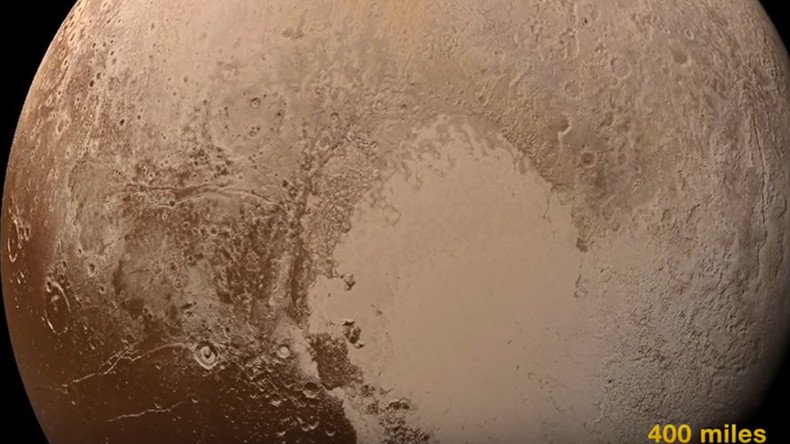Colorful arrival: NASA unveils what landing approach to Pluto would look like (VIDEO)

Ever dreamt of landing on another planet? It appears that NASA scientists have – and now they’ve expertly glued together several dozen images to make a video that shows you just what it would be like to land on Pluto!
Over 100 photos taken from NASA’s New Horizons spacecraft during its approach and close flyby of the dwarf planet over six weeks in the summer of 2015 have been combined to make this video, which shows you space lovers just how colorful it would be to land on Pluto.
The video starts with a distant view of Pluto and its largest moon, Charon, and then zooms towards it, taking you down to within 15 miles (24km) of the surface above the tall mountains on the planet’s icy plains.
Creative scientists used a number of detailed black and white frames of Pluto, and then combined them with color from low-resolution pictures taken by the Ralph color camera aboard New Horizons, which gave the video the best simulation of what it would actually look like to “drive” into Pluto from space in full color. The more curious can view the original black and white video on the New Horizons website.
READ MORE: Pull on Pluto’s ‘icy heart’ shifted dwarf planet’s axis – studies
“Just over a year ago, Pluto was a dot in the distance,” New Horizons Principal Investigator Alan Stern of the Southwest Research Institute in Colorado said.
“This video shows what it would be like to ride aboard an approaching spacecraft and see Pluto grow to become a world, and then to swoop down over its spectacular terrains as if we were approaching some future landing on them!”
Scientists reveal what Pluto’s mysterious ‘heart’ is made of https://t.co/Avr4rxD60kpic.twitter.com/bl1gjo14fK
— RT (@RT_com) June 3, 2016
Thursday marked the 11th anniversary of the launch of NASA’s New Horizons spacecraft. Its voyage has covered more than three billion miles so far. It flew through the Pluto system on July 14, 2015, coming within just 12,500 kilometers (7,800 miles) of the dwarf planet. With powerful telescopic cameras that can recognize objects smaller than a football field, its value is hard to overestimate – over the years it has sent back hundreds of images of Pluto and its moons, which have given us a glimpse of what the farthest corners of our solar system look, as well as a mountain of evidence that shows the dwarf planet, once thought to be a cold, dead world, is actually full of geological activity.
Currently hundreds of millions of kilometers past Pluto, New Horizons is getting ever closer to the outskirts of our solar system. Its next target, known as 2014 MU69, is a small, icy rock inside the Kuiper Belt, which it is scheduled to fly by on January 1, 2019.












